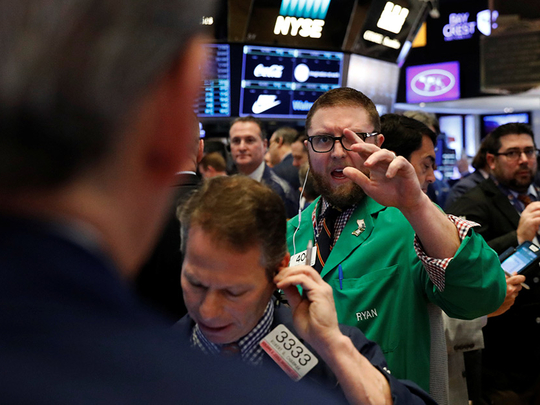
Dubai: The market volatility seen during last week’s market turmoil may fade this week, but investors still need to keep an eye on bond markets for direction, according to analysts.
“From here, implied volatility will, in all likelihood, fall. But investors shouldn’t expect the unusual calm of recent months to resume. The pullback in equity markets was originally rooted in concerns about higher US bond yields. And those concerns are resurfacing,” Mark Haefele, global chief investment officer at UBS said.
The Cboe Volatility Index, also known as the VIX or the Fear Index, which indicates market expectations of near-term volatility depending on options, fell by more than 50 per cent to 19.13 compared to a peak of 50.3 seen on February 5, matching the levels seen during the global financial crises in 2008.
Vijay Valecha, chief market analyst at Century Financial agreed.
“This slide in VIX prices is definitely a good scenario for the stock markets, at least for now. Given the probability of rising interest rates and inflation, we don’t expect the index to stay below 20 for long,” Valecha said.
UBS said it will continue its overweight rating on global equities over six-month investment horizon, but warns that bond market uncertainties may make the ride up bumpier than usual.
Threat
“Although bond yields retreated as equities tumbled, they have already started to rise again: from last week’s low of 2.65 per cent to a recent high of 2.88 per cent. Higher bond yields pose a threat to equity markets — making equities look relatively less attractively valued, raising corporate borrowing costs, and potentially signalling concerns about the future path of central bank policy,” Haefele said.
The Dow Jones Industrial Average has recovered partially after falling 10.2 per cent from its peak. On Friday, the Dow rose for a sixth straight session, closing 0.08 per cent higher at 25219.38. The index has been on a gaining streak since February 8, registering more than 5.5 per cent gains, its biggest one-week percentage rise since November 2016. The S&P 500 index also closed 0.04 per cent higher at 2,732.22. Global equity markets had been witnessing a massive sell-off since the past two weeks, triggered by rising bond yields due to expectations of higher inflation.
Factbox: Oil
Recovering global equities and a weaker dollar lent support to oil prices last week.
Brent crude rose 0.8 per cent on Friday to $64.84 (Dh237.96) per barrel, after hitting its highest level in a week. Brent rose 3 per cent last week, partially recovering from an eight per cent fall the previous week.
US West Texas Intermediate (WTI) rose 0.6 per cent, to $61.68 per barrel. WTI gained 4 per cent this week after losing nearly 10 per cent last week.
“We turn neutral on oil after seeing the price almost reach our first quarter downside objective. However, a weaker dollar driven by increased concerns about the US economic outlook is not a strong enough foundation from where a price recovery can be established. On that basis we expect the market to remain rangebound for the time being,” said Ole Hansen, head of commodity strategy at Saxo Bank.
In other commodities, gold rose to as much as $1,361 an ounce, the biggest weekly gain in nearly two years due to dollar weakness and inflation concerns.
“We maintain a bullish outlook for gold but would use current levels to reduce exposure and either wait for a pullback or a break above $1,375 [per ounce] to re-enter,” Hansen said.












